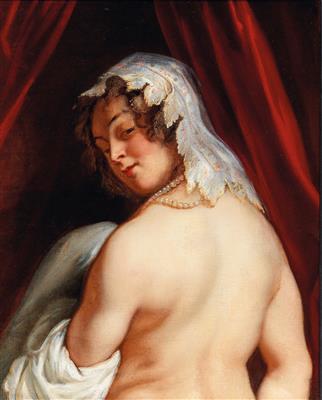Jacob Jordaens

(Antwerp 1593–1678)
The wife of King Candaules,
oil on canvas, 66.5 x 54 cm, framed
Provenance:
possibly Coenraad Baron Droste;
his sale, The Hague, 21 July 1734, lot 4;
probably purchased by the previous owner at a sale in California, USA;
sale, Sotheby’s, London, 5 July 2017, lot 51;
where acquired by the present owner
The present picture by Jacob Jordaens captures the moment in which the queen of Lydia, wearing only a lace cap and pearl necklace, steps into her bed. Those familiar with the story would know that she is secretly being watched by her husband and one of his guards. The painting is a modello for a larger composition (showing those two additional figures) entitled King Candaules Lets Gyges Spy on His Wife in the National Museum, Stockholm (see fig.1)
In Counter-Reformation Antwerp the episode of King Candaules was used as a morality tale. It comes from Herodotus’ Histories and served as an example of the sanctity of the marital bedchamber and the fate awaiting those who violated it. According to Herodotus, Candaules, dishonouring his queen, chose to make a show of his wife’s beauty to his favourite sentinel, Gyges. Insisting that Gyges hide behind a curtain, Candaules and his guard can be seen at the right of the Stockholm picture, peering at the disrobed queen.
In Herodotus’ account, the queen spotted Gyges leaving her chamber, and later confronted him. She gave him the choice of either facing execution or killing her husband and reigning alongside her as consort. Gyges consented to kill the perfidious Candaules. Jordaens treats the subject in a novel way, as can be perceived in the present modello, where the queen looks out at us with a conspiratorial smile, seemingly aware of both her temporal and sensual power.
Jordaens, like Peter Paul Rubens, was a pupil of the Antwerp painter Adam van Noort. He collaborated with Rubens both in 1634 in the decorations to mark the Joyeuse Entrée of the Cardinal Infante Ferdinand and in 1637/38 on the cycle of paintings intended for the decoration of the Torre de la Parada in Madrid. The present composition was painted at the height of Jordaens’s powers, when after the deaths of Rubens in 1640 and of van Dyck in 1641 he had become the principle painter of what is now regarded as Southern-Netherlandish Baroque.
This painting is likely the same work recorded as by Jordaens and of corresponding measurements (23 duim x 19 duim), described as depicting Queen Tomyris, sold in the sale of Baron Droste in The Hague in 1734.
Esperto: Damian Brenninkmeyer
 Damian Brenninkmeyer
Damian Brenninkmeyer
+43 1 515 60 403
oldmasters@dorotheum.com
22.10.2019 - 17:00
- Prezzo realizzato: **
-
EUR 75.385,-
- Stima:
-
EUR 60.000,- a EUR 80.000,-
Jacob Jordaens
(Antwerp 1593–1678)
The wife of King Candaules,
oil on canvas, 66.5 x 54 cm, framed
Provenance:
possibly Coenraad Baron Droste;
his sale, The Hague, 21 July 1734, lot 4;
probably purchased by the previous owner at a sale in California, USA;
sale, Sotheby’s, London, 5 July 2017, lot 51;
where acquired by the present owner
The present picture by Jacob Jordaens captures the moment in which the queen of Lydia, wearing only a lace cap and pearl necklace, steps into her bed. Those familiar with the story would know that she is secretly being watched by her husband and one of his guards. The painting is a modello for a larger composition (showing those two additional figures) entitled King Candaules Lets Gyges Spy on His Wife in the National Museum, Stockholm (see fig.1)
In Counter-Reformation Antwerp the episode of King Candaules was used as a morality tale. It comes from Herodotus’ Histories and served as an example of the sanctity of the marital bedchamber and the fate awaiting those who violated it. According to Herodotus, Candaules, dishonouring his queen, chose to make a show of his wife’s beauty to his favourite sentinel, Gyges. Insisting that Gyges hide behind a curtain, Candaules and his guard can be seen at the right of the Stockholm picture, peering at the disrobed queen.
In Herodotus’ account, the queen spotted Gyges leaving her chamber, and later confronted him. She gave him the choice of either facing execution or killing her husband and reigning alongside her as consort. Gyges consented to kill the perfidious Candaules. Jordaens treats the subject in a novel way, as can be perceived in the present modello, where the queen looks out at us with a conspiratorial smile, seemingly aware of both her temporal and sensual power.
Jordaens, like Peter Paul Rubens, was a pupil of the Antwerp painter Adam van Noort. He collaborated with Rubens both in 1634 in the decorations to mark the Joyeuse Entrée of the Cardinal Infante Ferdinand and in 1637/38 on the cycle of paintings intended for the decoration of the Torre de la Parada in Madrid. The present composition was painted at the height of Jordaens’s powers, when after the deaths of Rubens in 1640 and of van Dyck in 1641 he had become the principle painter of what is now regarded as Southern-Netherlandish Baroque.
This painting is likely the same work recorded as by Jordaens and of corresponding measurements (23 duim x 19 duim), described as depicting Queen Tomyris, sold in the sale of Baron Droste in The Hague in 1734.
Esperto: Damian Brenninkmeyer
 Damian Brenninkmeyer
Damian Brenninkmeyer
+43 1 515 60 403
oldmasters@dorotheum.com
|
Hotline dell'acquirente
lun-ven: 10.00 - 17.00
old.masters@dorotheum.at +43 1 515 60 403 |
| Asta: | Dipinti antichi I |
| Tipo d'asta: | Asta in sala |
| Data: | 22.10.2019 - 17:00 |
| Luogo dell'asta: | Wien | Palais Dorotheum |
| Esposizione: | 12.10. - 22.10.2019 |
** Prezzo d'acquisto comprensivo di tassa di vendita e IVA(Paese di consegna Austria)
Non è più possibile effettuare un ordine di acquisto su Internet. L'asta è in preparazione o è già stata eseguita.
Altri oggetti dell'artista
-

Stima:
EUR 90.000,- a EUR 120.000,-
